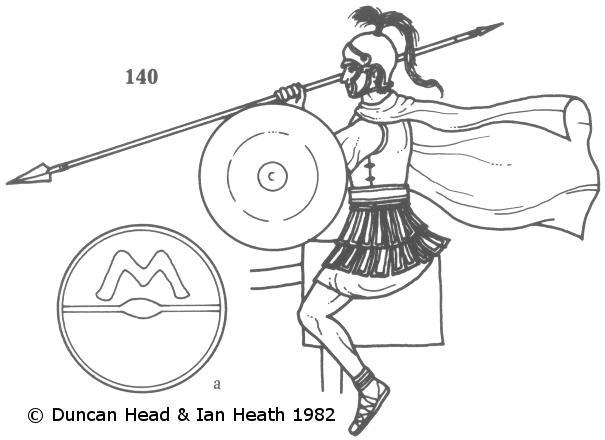
Join Amazon Prime - Watch Thousands of Movies & TV Shows Anytime - Start Free Trial Now
2nd CENTURY ROMAN CAVALRYMAN
An extract from Armies of the Macedonian and Punic Warsby Duncan Head, illustrated by Ian Heath

140. 2nd CENTURY ROMAN CAVALRYMAN


Because of these deficiencies, Roman cavalry adopted the Greek-influenced equipment of this figure, who is from an Imperial copy of the 2nd century BC relief of Mettius Curtius, at Rome. Unfortunately Polybios does not give the date of this reform, but as he says the equipment worn “anciently” was “soon” replaced, the change probably occurred during or soon after Rome’s first clash with Greek cavalry, in the Pyrrhic war. The later wars with Macedon and the Seleucids seem too close to Polybios’ own day, as he implies the reform was well in the past. One alternative that has been suggested is that Scipio Africanus introduced the new equipment during the second Punic war. While Roman cavalry may have been more effective at the end of that war than the beginning, Polybios’ close ties with the Scipios surely mean that he would have claimed for them any credit going for this reform, while he does specifically mention Greek, not Carthaginian, influence. On balance the Pyrrhic date seems most likely.
The relief shows a short Hellenistic plate cavalry cuirass and Attic helmet. Alternatively, the cavalry on the Aemilius Paullus monument have mail. The shield is now larger, but though Polybios says the Romans adopted “firm and stout” shields from the Greeks, Mettius Curtius’ shield does not match any known Greek type, but seems to be a variant of the oxhide parma equestris, slightly larger than the last figure’s and with a metal boss recessed in the centre. This style is still shown on a coin of Augustus. The ribbed style of 46 and 130e was also used; 140a is the shield of 130e’s opponent, a cavalryman shown on a Roman coin. It has a curious ‘M’-shaped blazon of uncertain significance; when I first saw it I thought it was an eagle, but if so it is remarkably crude even given the limitations of the medium. Silius Italicus mentions a consul whose shield was blazoned with Romulus and the wolf, but this may be mere poetic fancy.
The thrusting spear is now “steady and strong” and carries a buttspike. It is clearly modelled on the Macedonian xyston, but the relief shows the Roman spear was shorter, about 6 feet (l.8m). A Spanish sword would be carried, and the cavalry on the Aemilius Paullus monument certainly had swords at the right of their waistbelts.
Cavalry very like this figure are shown fighting naked Gauls on a relief from Lecce in Apulia, 3rd or 2nd century BC. They are probably local allies, indicating that this figure’s style of equipment replaced that of 151-153 and 158-160 in the south.